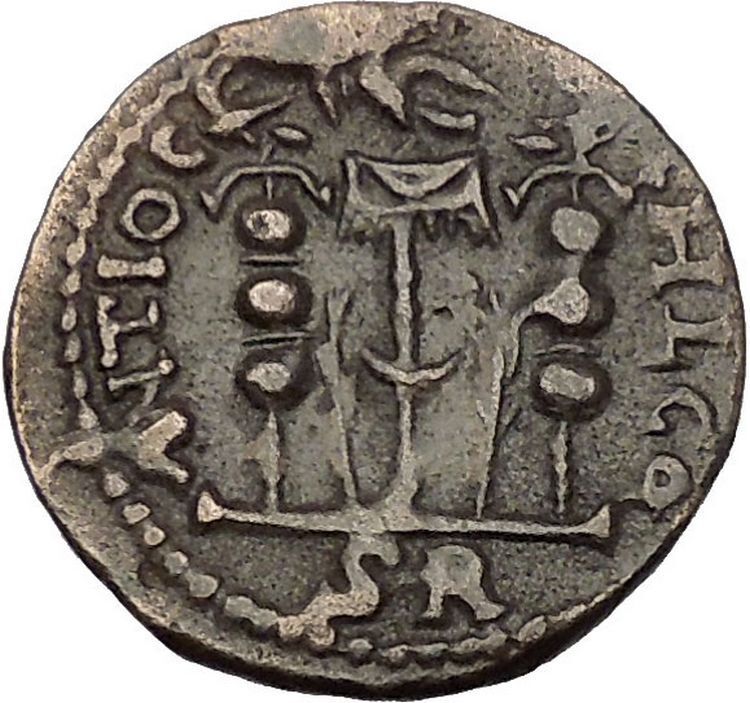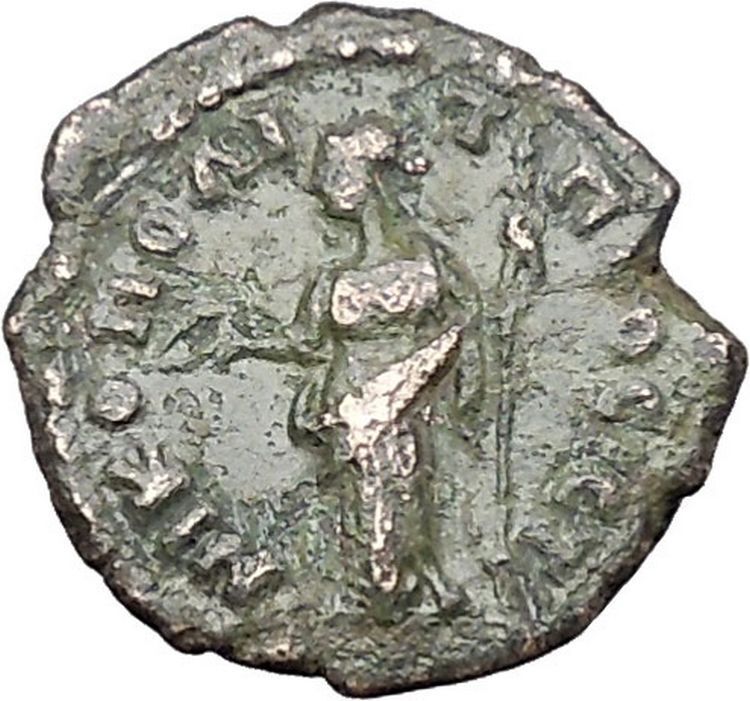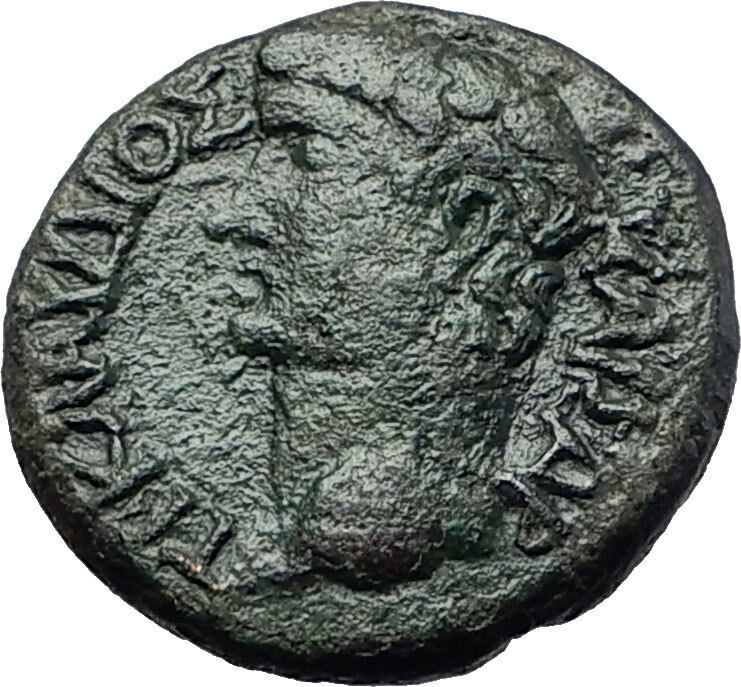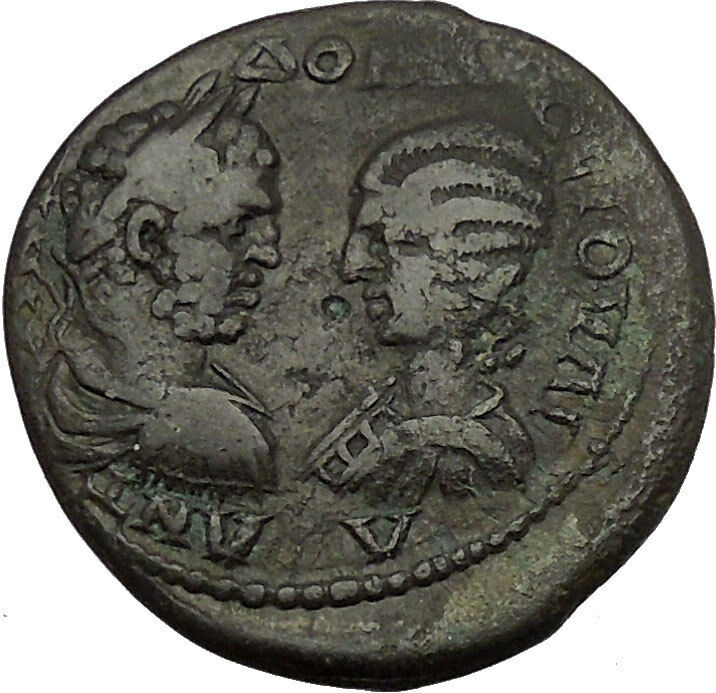|
Severus Alexander – Roman Emperor: 222-235 A.D.
Bronze 20mm (4.26 grams) of <font color="#000000" ionia Nicomedia in Bithynia
Second Neocorate Status
Reference: RecGen 319 var (third neokorus); SNG Cop. 578 var (ditto)
M AVP CEVH ΑΛΕΞΑΝΔΡΟC AVΓ, Laureate, draped and cuirassed bust right.
NIKOMHΔΕΩΝ ΔΙC ΝΕΩ, half-nude female, standing facing, head left, foot on prow, right hand outstretched, holding sceptre over left shoulder.
You are bidding on the exact item pictured, provided with a Certificate of Authenticity and Lifetime Guarantee of Authenticity.
Nicomedia (Greek: Νικομήδεια, Nikomedeia; modern İzmit) was an ancient city in what is now Turkey, founded in 712/11 BC as a Megarian colony and was originally known as Astacus (/ˈæstəkəs/; Ancient Greek: Ἀστακός, “lobster”). After being destroyed by Lysimachus, it was rebuilt by Nicomedes I of Bithynia in 264 BC under the name of Nicomedia, and has ever since been one of the most important cities in northwestern Asia Minor. The great military commander Hannibal Barca came to Nicomedia in his final years and committed suicide in nearby Libyssa (Diliskelesi, Gebze). The historian Arrian was born there.
Nicomedia was the metropolis of Bithynia under the Roman Empire, and Diocletian made it the eastern capital city of the Roman Empire in 286 when he introduced the Tetrarchy system. Nicomedia remained as the eastern (and most senior) capital of the Roman Empire until co-emperor Licinius was defeated by Constantine the Great at the Battle of Chrysopolis (Üsküdar) in 324. Constantine mainly resided in Nicomedia as his interim capital city for the next six years, until in 330 he declared the nearby Byzantium (which was renamed Constantinople) the new capital. Constantine died in a royal villa in the vicinity of Nicomedia in 337. Owing to its position at the convergence of the Asiatic roads leading to the new capital, Nicomedia retained its importance even after the foundation of Constantinople.
A major earthquake, however, on 24 August 358, caused extensive devastation to Nicomedia, and was followed by a fire which completed the catastrophe. Nicomedia was rebuilt, but on a smaller scale. In the sixth century under Emperor Justinian I the city was extended with new public buildings. Situated on the roads leading to the capital, the city remained a major military center, playing an important role in the Byzantine campaigns against the Caliphate.
In 451, the local bishopric was promoted to a Metropolitan see under the jurisdiction of the Ecumenical Patriarchate of Constantinople. The metropolis of Nicomedia was ranked 7th in the Notitiae Episcopatuum among the metropolises of the Patriarchate. From the 840s on, Nicomedia was the capital of the thema of the Optimatoi. By that time, most of the old, seawards city had been abandoned and is described by the Persian geographer Ibn Khurdadhbih as lying in ruins. The settlement had obviously been restricted to the hilltop citadel. In the 1080s, the city served as the main military base for Alexios I Komnenos in his campaigns against the Seljuk Turks, and the First and Second Crusades both encamped there.
The city was briefly held by the Latin Empire following the fall of Constantinople to the Fourth Crusade in 1204: in late 1206 the seneschal Dietrich von Los made it his base, converting the church of Saint Sophia into a fortress; however the Crusader stronghold was subjected to constant raids by the Emperor of Nicaea Theodore I Laskaris, during which von Los was captured by Nicaean soldiers; by the summer of 1207 Emperor Henry of Flanders to agreed to evacuate Nicomedia in exchange for von Los and other prisoners Emperor Theodore held. The city remained in Byzantine control for over a century after that, but following the Byzantine defeat at the Battle of Bapheus in 1302, it was threatened by the rising Ottoman beylik. The city was twice blockaded by the Ottomans (in 1304 and 1330) before finally succumbing in 1337.
Notable natives and residents
- Saint Panteleimon
- Adrian of Nicomedia
- Anthimus of Nicomedia
- Arrian (Lucius Flavius Arrianus ‘Xenophon’)
- Juliana of Nicomedia
- Michael Psellos (11th century) Greek writer, philosopher, politician, and historian
- Maximus Planudes (13th century) Greek scholar, anthologist, translator and grammarian
- Saint Barbara
- Saint George
- Theopemptus of Nicomedia
- Diocletian
- Theophylact of Nicomedia
See also
- 20,000 Martyrs of Nicomedia
- Nicaea (present-day İznik, another important city in Bithynia, and the interim Byzantine capital city between 1204 and 1261 (Empire of Nicaea) following the Fourth Crusade in 1204, until the recapture of Constantinople by the Byzantines in 1261. Earlier, the site of the Nicene Creed as well as the First Council of Nicaea and Second Council of Nicaea.)
SEVERUS ALEXANDER
 Augustus: A.D. 222-235 Augustus: A.D. 222-235
Caesar: A.D. 221-222 under Elagabalus
Son of Julia Mamaea
Husband of Orbiana
Grandson of Julia Maesa
Nephew of Julia Soaemias
Cousin of Elagabalus
Second-cousin of Caracalla and Geta
Great-newphew of Septimius Severus and Julia Domna
Marcus Aurelius Severus Alexander (October 1, 208–March 18, 235 AD), commonly called Alexander Severus, was the last Roman emperor (11 March 222–235) of the Severan dynasty. Alexander Severus succeeded his cousin, Elagabalus upon the latter’s assassination in 222 AD, and was ultimately assassinated himself, marking the epoch event for the Crisis of the Third Century—nearly fifty years of disorder, Roman civil wars, economic chaos, regional rebellions, and external threats that brought the Empire to near-collapse.
Alexander Severus was the heir apparent to his cousin, the eighteen-year-old Emperor who had been murdered along with his mother by his own guards—and as a mark of contempt, had their remains cast into the Tiber river. He and his cousin were both grandsons of the influential and powerful Julia Maesa, who had arranged for Elagabalus’ acclamation as Emperor by the famed Third Gallic Legion.
A rumor of Alexander’s death circulated, triggering the assassination of Elagabalus.
Alexander’s reign was marked by troubles. In military conflict against the rising Sassanid Empire, there are mixed accounts, though the Sassanid threat was checked. However, when campaigning against Germanic tribes of Germania, Alexander Severus apparently alienated his legions by trying diplomacy and bribery, and they assassinated him.
Life
Alexander was born with the name Marcus Julius Gessius Bassianus Alexianus. Alexander’s father, Marcus Julius Gessius Marcianus was a Syrian Promagistrate. His mother Julia Avita Mamaea was the second daughter of Julia Maesa and Syrian noble Julius Avitus and maternal aunt of Emperor Elagabalus. He had an elder sister called Theoclia and little is known about her. Alexander’s maternal great-aunt was empress Julia Domna (also Maesa’s younger sister) and his great-uncle in marriage was emperor Lucius Septimius Severus. Emperors Caracalla and Publius Septimius Geta, were his mother’s maternal cousins. In 221, Alexander’s grandmother, Maesa, persuaded the emperor to adopt his cousin as successor and make him Caesar and Bassianus changed his name to Alexander. In the following year, on March 11, Elagabalus was murdered, and Alexander was proclaimed emperor by the Praetorians and accepted by the Senate.
When Alexander became emperor, he was young, amiable, well-meaning, and entirely under the dominion of his mother. Julia Mamaea was a woman of many virtues, and she surrounded the young emperor with wise counsellors. She watched over the development of her son’s character and improved the tone of the administration. On the other hand, she was inordinately jealous. She also alienated the army by extreme parsimony, and neither she nor her son were strong enough to impose military discipline. Mutinies became frequent in all parts of the empire; to one of them the life of the jurist and praetorian praefect Ulpian was sacrificed; another compelled the retirement of Cassius Dio from his command.
On the whole, however, the reign of Alexander was prosperous until the rise, in the east, of the Sassanids. Of the war that followed there are various accounts. (Mommsen leans to that which is least favourable to the Romans). According to Alexander’s own dispatch to the senate, he gained great victories. At all events, though the Sassanids were checked for the time, the conduct of the Roman army showed an extraordinary lack of discipline. The emperor returned to Rome and celebrated a triumph in 233.
The following year he was called to face German invaders in Gaul, who had breached the Rhine frontier in several places, destroying forts and over-running the countryside. Alexander mustered his forces, bringing legions from the eastern provinces, and crossed the Rhine into Germany on a pontoon bridge. Initially he attempted to buy the German tribes off, so as to gain time. Whether this was a wise policy or not, it caused the Roman legionaries to look down on their emperor as one who was prepared to commit unsoldierly conduct. Herodian says “in their opinion Alexander showed no honourable intention to pursue the war and preferred a life of ease, when he should have marched out to punish the Germans for their previous insolence”. These circumstances drove the army to look for a new leader. They chose Gaius Iulius Verus Maximinus, a Thracian soldier who had worked his way up through the ranks.
Following the nomination of Maximinus as emperor, Alexander was slain (on either March 18 or March 19, 235), together with his mother, in a mutiny of the Legio XXII Primigenia. These assassinations secured the throne for Maximinus.
The death of Alexander is considered as the end of the Principate system established by Augustus. Although the Principate continued in theory until the reign of Diocletian, Alexander Severus’ death signalled the beginning of the chaotic period known as the Crisis of the Third Century which weakened the empire considerably.
Legacy
Alexander was the last of the Syrian emperors. Under the influence of his mother, he did much to improve the morals and condition of the people. His advisers were men like the famous jurist Ulpian, the historian Cassius Dio and a select board of sixteen senators; a municipal council of fourteen assisted the urban praefect in administering the affairs of the fourteen districts of Rome. The luxury and extravagance that had formerly been so prevalent at the court were put down; the standard of the coinage was raised; taxes were lightened; literature, art and science were encouraged; the lot of the soldiers was improved; and, for the convenience of the people, loan offices were instituted for lending money at a moderate rate of interest.
In religious matters Alexander preserved an open mind. It is said that he was desirous of erecting a temple to the founder of Christianity, but was dissuaded by the pagan priests.
Marriage
Alexander was married three times. His most famous wife was Sallustia Orbiana, Augusta, whom he married in 225. He divorced and exiled her in 227, after her father, Seius Sallustius, was executed for attempting to assassinate the emperor. Another wife was Sulpicia Memmia. Her father was a man of consular rank; her grandfather’s name was Catulus.
|




 Augustus: A.D. 222-235
Augustus: A.D. 222-235




